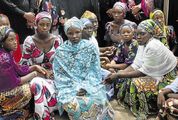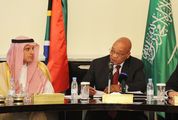GERMAN Chancellor Angela Merkel was there to watch her team play. President Cristina Fernandez de Kirchner of Argentina was not. But there was President Jacob Zuma at the Soccer World Cup final on Sunday.
Perhaps he was there because SA hosted the previous World Cup.
Or perhaps the Brics (Brazil, Russia, India, China, SA) summit, which opened on Tuesday in the Brazilian city of Fortaleza, provided a convenient excuse for a trip to the soccer final.
Poor economic performances from the likes of Brazil are one reason the Brics bloc does not look nearly as attractive as it once did. But SA looks even more of a misfit in that company. Who do we think we’re kidding?
It is not that SA is a complete write-off compared to its Brics counterparts, at least when it comes to sovereign ratings and local currency ratings.
But take SA’s export competitiveness — where performance is crucial for growth and job creation prospects — and we lag laughably behind the bloc. A World Bank study published earlier this year finds that SA’s share of the global export market stagnated over the decade to 2012, while the Brics share more than doubled.
There has been much concern lately about how slow SA’s manufactured exports have been to respond to the weakening of the rand, but the World Bank study suggests this reflects a longstanding problem with SA’s export competitiveness. SA had real export growth of just 0.6% a year from 2005 to 2011, against 6.4% for middle-income countries (including the Brics).
Mineral export volumes have been virtually flat since 2001; non-mineral export volumes have been virtually flat, and that includes services. The other Brics countries have grown their services exports since 2005; SA has not, even though services account for about two-thirds of SA’s economy.
All this makes the National Development Plan’s target of growing export volumes 6% a year seem ambitious. But the World Bank’s report is even more interesting on the structure of SA’s export market, which is dominated by a few "super-exporters" that account for 5% of exporting companies but 90% of exports. They are losing dynamism and competitiveness, says the World Bank, and the smaller, newer exporters aren’t coming up fast enough to offset this.
The study’s findings, and some its prescriptions, should be a challenge to policy makers because they are not the obvious ones. For example, it turns out that we are surprisingly good at sophisticated, medium-to hi-tech exports. That’s good, in the sense that SA is not trapped in low-tech, but doesn’t do much to address our need for lots of low-skilled jobs or inclusive growth.
Then there’s sub-Saharan Africa, which is a real export success story — its share of SA’s exports has jumped from 19% to 29% since the early 2000s, over which time the European Union’s share has fallen from 41% to 28%. Exports to Brics countries, mainly of minerals, have also jumped over the period, from 5% to 19%.
Africa now accounts for about half of SA’s non-mineral exports, which is good, the World Bank’s researchers point out, but they warn that Africa’s market is still much smaller than Europe’s, so SA can grow exports only so much if it cannot compete globally.
But that requires more competition in our domestic market — and one way to get more exports, the study implies, is to encourage imports. It was through trade policy reforms, when SA lowered tariff barriers in the 1990s, that the government had the biggest influence on competition, says the study, but that process has stalled. Insufficient competition at home is bad for exports because protected firms don’t have enough incentive to export.
Although the study is polite about SA’s sector-specific industrial policies, this hardly seems the answer to the problem. It is trade policy which could be more useful. The study calls for infrastructure constraints to be addressed to promote exports. It draws attention not just to electricity, but to Transnet’s freight tariff structures, which work against smaller, newer export producers, and staggeringly high port charges, including container tariffs, which are 360% of the global average, and to SA’s poor broadband infrastructure and high charges.
All of which should challenge policy makers to think differently about how to shift SA’s position in global markets. The question is whether SA can see past its Brics aspirations to focus on its own realities and how to fix them.
• Joffe is editor at large.
(Front, left to right) Maite Nkoana-Mashabane, President Jacob Zuma and Nhlanhla Nene exhange a few words at a Brics (Brazil Russia, India, China and South Africa) summit in Brazil on Tuesday. Picture: GCIS
GERMAN Chancellor Angela Merkel was there to watch her team play. President Cristina Fernandez de Kirchner of Argentina was not. But there was President Jacob Zuma at the Soccer World Cup final on Sunday.
Perhaps he was there because SA hosted the previous World Cup.
Or perhaps the Brics (Brazil, Russia, India, China, SA) summit, which opened on Tuesday in the Brazilian city of Fortaleza, provided a convenient excuse for a trip to the soccer final.
Poor economic performances from the likes of Brazil are one reason the Brics bloc does not look nearly as attractive as it once did. But SA looks even more of a misfit in that company. Who do we think we’re kidding?
It is not that SA is a complete write-off compared to its Brics counterparts, at least when it comes to sovereign ratings and local currency ratings.
But take SA’s export competitiveness — where performance is crucial for growth and job creation prospects — and we lag laughably behind the bloc. A World Bank study published earlier this year finds that SA’s share of the global export market stagnated over the decade to 2012, while the Brics share more than doubled.
There has been much concern lately about how slow SA’s manufactured exports have been to respond to the weakening of the rand, but the World Bank study suggests this reflects a longstanding problem with SA’s export competitiveness. SA had real export growth of just 0.6% a year from 2005 to 2011, against 6.4% for middle-income countries (including the Brics).
Mineral export volumes have been virtually flat since 2001; non-mineral export volumes have been virtually flat, and that includes services. The other Brics countries have grown their services exports since 2005; SA has not, even though services account for about two-thirds of SA’s economy.
All this makes the National Development Plan’s target of growing export volumes 6% a year seem ambitious. But the World Bank’s report is even more interesting on the structure of SA’s export market, which is dominated by a few "super-exporters" that account for 5% of exporting companies but 90% of exports. They are losing dynamism and competitiveness, says the World Bank, and the smaller, newer exporters aren’t coming up fast enough to offset this.
The study’s findings, and some its prescriptions, should be a challenge to policy makers because they are not the obvious ones. For example, it turns out that we are surprisingly good at sophisticated, medium-to hi-tech exports. That’s good, in the sense that SA is not trapped in low-tech, but doesn’t do much to address our need for lots of low-skilled jobs or inclusive growth.
Then there’s sub-Saharan Africa, which is a real export success story — its share of SA’s exports has jumped from 19% to 29% since the early 2000s, over which time the European Union’s share has fallen from 41% to 28%. Exports to Brics countries, mainly of minerals, have also jumped over the period, from 5% to 19%.
Africa now accounts for about half of SA’s non-mineral exports, which is good, the World Bank’s researchers point out, but they warn that Africa’s market is still much smaller than Europe’s, so SA can grow exports only so much if it cannot compete globally.
But that requires more competition in our domestic market — and one way to get more exports, the study implies, is to encourage imports. It was through trade policy reforms, when SA lowered tariff barriers in the 1990s, that the government had the biggest influence on competition, says the study, but that process has stalled. Insufficient competition at home is bad for exports because protected firms don’t have enough incentive to export.
Although the study is polite about SA’s sector-specific industrial policies, this hardly seems the answer to the problem. It is trade policy which could be more useful. The study calls for infrastructure constraints to be addressed to promote exports. It draws attention not just to electricity, but to Transnet’s freight tariff structures, which work against smaller, newer export producers, and staggeringly high port charges, including container tariffs, which are 360% of the global average, and to SA’s poor broadband infrastructure and high charges.
All of which should challenge policy makers to think differently about how to shift SA’s position in global markets. The question is whether SA can see past its Brics aspirations to focus on its own realities and how to fix them.
• Joffe is editor at large.



















Change: -0.47%
Change: -0.57%
Change: -1.76%
Change: -0.34%
Change: 0.02%
Data supplied by Profile Data
Change: -1.49%
Change: 0.20%
Change: -0.47%
Change: 0.00%
Change: 0.00%
Data supplied by Profile Data
Change: 0.16%
Change: 0.60%
Change: 0.14%
Change: -0.29%
Change: 0.70%
Data supplied by Profile Data
Change: 0.20%
Change: -0.42%
Change: 0.26%
Change: -1.57%
Change: -0.77%
Data supplied by Profile Data